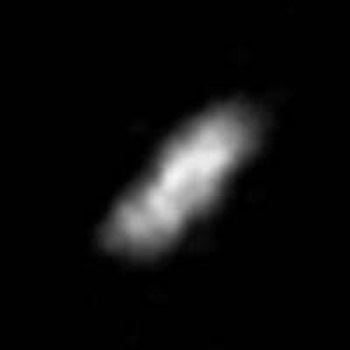Discovery date September 1989 Eccentricity 0.0002 ± 0.0002 Discovered September 1989 Discoverer Richard J. Terrile Apparent magnitude 23.3 | Semi-major axis 50 075 ± 1 km Satellite of Neptune Orbital period 7 hours Orbits Neptune | |
 | ||
Discovered by Richard J. Terrile and Voyager Imaging Team Inclination 0.21 ± 0.02° (to Neptune equator)
0.21° (to local Laplace plane) Similar Richard J Terrile discoveries, Neptune moons, Other celestial objects | ||
Thalassa (/θəˈlæsə/ thə-LASS-ə; Greek: Θάλασσα), also known as Neptune IV, is the second innermost satellite of Neptune. Thalassa was named after sea goddess Thalassa, a daughter of Aether and Hemera from Greek mythology. "Thalassa" is also the Greek word for "sea".
Thalassa was discovered sometime before mid-September 1989 from the images taken by the Voyager 2 probe. It was given the temporary designation S/1989 N 5. The discovery was announced (IAUC 4867) on September 29, 1989, but the text only talks of "25 frames taken over 11 days", giving a discovery date of sometime before September 18. The name was given on 16 September 1991.
Thalassa is irregularly shaped and shows no sign of any geological modification. It is likely that it is a rubble pile re-accreted from fragments of Neptune's original satellites, which were smashed up by perturbations from Triton soon after that moon's capture into a very eccentric initial orbit. Unusually for irregular bodies, it appears to be roughly disk-shaped.
Since the Thalassian orbit is below Neptune's synchronous orbit radius, it is slowly spiralling inward due to tidal deceleration and may eventually impact Neptune's atmosphere, or break up into a planetary ring upon passing its Roche limit due to tidal stretching. Relatively soon after, the spreading debris may impinge upon Despina's orbit.
